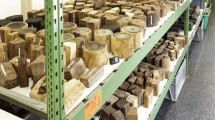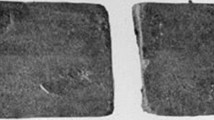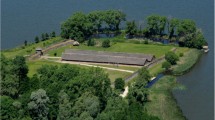Abstract
The first step to study archaeological wood is to define how it is preserved, so as to apply the most suitable preparation procedure. Archaeological wood may be waterlogged, dried, charred, or mineralized. Here we describe two commonly used procedures: sectioning is applied to waterlogged or desiccated wood and fracturing is used with charcoal and mineralized wood. Both preparation techniques for wood and charcoal are fast and effective and allow analysis of large numbers of wood fragments in a relatively short time. However, they have the main disadvantage of being destructive techniques, producing further fragmentation and loss of study material. For this reason, it is recommended that the preparation of archaeological woods is always carried out with caution not to produce irreparable damage to materials that in some cases may be precious and unique.
Access provided by Autonomous University of Puebla. Download chapter PDF
Similar content being viewed by others
Keywords
1 Introduction
The preparation of wood samples from archaeological contexts largely depends on the preservation type and on the chemical and physical state of the material, which may vary from near normal to highly degraded [1]. Compared to fresh wood, archaeological materials have generally undergone hydrolysis and/or degradation through the action of fungi, bacteria, and other soil microorganisms, especially in oxygen-rich environments [2, 3]. Archaeological wood may be waterlogged, dried, charred, or mineralized. It can also present a combination of preservation types (e.g., waterlogged and mineralized [4]). As such, different portions of the same wood fragment may require different treatments. For this reason, while several attempts have been made to standardize the preparation methods for archaeological wood [1, 5–8], it is a common experience that each case study may need some adjustment after the application of standard procedures.
The first step to study archaeological wood is to define how it is preserved, so as to apply the most suitable procedure (see Chap. 25).
Waterlogged wood is found in permanently submerged and poorly oxygenated soils, where plant tissues may maintain their anatomical structure and original shape, especially when they are kept wet, cool, and dark [9]. Once the wood is exposed to air, the cell walls will collapse and the wood will shrink and warp, so it is necessary to examine the specimen immediately, before any distortion occurs.
Desiccated wood is recovered from dry areas and generally appears intact. It may be rather difficult to prepare and identify, as it is often very light and extremely friable [7]. It should be kept in dry and rigid containers to avoid disintegration and humidity variations.
Charred or carbonized wood (anthracological remains) is the product of more or less prolong and incomplete combustion by fire. It is chemically highly inert and not subjected to the degrading action of microorganisms, so it may be recovered from soil horizons and archaeological contexts where uncharred plant materials cannot be preserved [10]. However, it undergoes a significant reduction in volume and can be extremely fragile. It should be stored in dry and rigid containers, to avoid fragmentation and crumbling. Charred wood may present well-preserved anatomical structures, allowing easy identification [11].
Mineralized wood may form when tissues are immersed in water containing a high concentration of dissolved minerals [12]. Dissolved carbonates, silicates, and phosphates, as well as metal oxides may precipitate around and within the wood fragment, filling the cell cavities. Iron-, silver-, and copper-oxides may be effective preservatives for wood material, as they are toxic to bacteria and fungi [13]. Mineralized woods may be very hard and do not require any particular care for conservation. In some cases, however, they may be fragile and crumbly, when only their outer surface is covered by a thin layer of oxides (Fig. 26.1).
a Mineralized fragment of poplar wood (Populus sp.) surrounded by leather, forming part of the sheath of a lance (Roman Imperial Age, Palatine Hill of Rome, Italy). Scale bar = 0.5 cm. b The transverse surface of the wood fragment, to the left, obtained by fracturing and observed under a stereomicroscope. Scale bar = 100 μm
Archaeological wood is sometimes found in large amounts, but in many cases only small fragments are available. They may be very delicate or may be part of priceless artefacts, so it is important to handle them very carefully, to use the minimum possible surface for identification, and to keep them stored in the same environmental conditions of their retrieval. In general, preparing archaeological wood is simple and allows processing of a large number of samples in a relatively short time [14].
Here we describe two different procedures in relation to different preservation states. Sectioning is usefully applied to waterlogged or desiccated wood. Fracturing is used with charcoal and mineralized wood. We do not describe the embedding procedures because in our experience they are complicated and unnecessary, besides being lengthy and wasteful of material [14].
2 Materials
2.1 Sectioning
-
1.
Waterlogged or desiccated wood fragment.
-
2.
A soft brush and/or a scalpel.
-
3.
Double-sided razor blade in a safety holder.
-
4.
Freezer (if the waterlogged sample is very soft or spongy).
-
5.
Hot water (if the desiccated sample is hard).
-
6.
Bleach (if the sample is dark) in a watch glass.
-
7.
Seventy percent glycerol.
-
8.
Forceps.
-
9.
Microscope slides and coverslips.
-
10.
Stereomicroscope.
-
11.
Transmitted light microscope.
2.2 Fracturing
-
1.
Charred, mineralized, or desiccated wood fragment.
-
2.
A soft brush and/or a scalpel.
-
3.
A small hammer (if the sample is very hard).
-
4.
Forceps with flexible tips.
-
5.
Plasticine or wax (or dried and clean poppy seeds).
-
6.
Glass slide or shallow disk.
-
7.
Stereomicroscope with objectives × 5, × 10, × 20, × 50, possibly with Nomarski differential interference contrast equipment.
-
8.
Scanning electron microscope (SEM) stubs, double-sided conductive tape, and environmental scanning electron microscope (ESEM; if examination under the stereoscopic microscope is not satisfactory).
3 Methods
3.1 Sectioning
-
1.
Define the preservation state of the wood sample, whether it is waterlogged or desiccated (see Note 1).
-
2.
Clean the surface of the sample with a soft brush and/or a scalpel to eliminate the embedding sediment.
-
3.
If the sample is dry, soften it through boiling in water, until it sinks. Alternatively, it can be soaked in water for hours or days until it is soft enough to be hand cut by a razor blade.
-
4.
If the sample is very soft or spongy, freeze it, or air dry it in the laboratory, avoiding vicinity to heat sources and ventilation. It is essential to frequently check the drying process in order to avoid rapid and excessive desiccation.
-
5.
If the sample was frozen, ensure that the equipment for sectioning is ready beforehand.
-
6.
Trim away the outer surface of the wood sample using a razor blade under a stereomicroscope, to obtain a clean surface along the transverse plane (see Note 2).
-
7.
Hand cut sections from the transverse plane using a new razor blade (see Note 3). When sectioning the sample, the blade should form an angle of 10–20° from the horizontal. If enough study material is available, different cutting angles can be tried, until a suitable section thickness is obtained. A section 15–20 μm thick would be optimal.
-
8.
If the sections are too dark for observation under the light microscope, soak them in a watch glass with a drop of bleach for a few minutes, and then rinse them in a watch glass with water.
-
9.
Delicately transfer the transversal sections onto a microscope slide using forceps and mount them in 70 % glycerol. Cover with a coverslip.
-
10.
Trim away the outer surface of the wood sample along the longitudinal (radial and tangential) planes (see Note 4 ).
-
11.
If the sections are too dark for observation under the light microscope, soak them in a watch glass with a drop of bleach for a few minutes, and then rinse them in a watch glass with water.
-
12.
Delicately transfer the radial and tangential sections to a microscope slide using forceps and mount them in 70 % glycerol. Cover with a coverslip.
-
13.
Observe the samples under the transmitted light microscope for identification.
3.2 Fracturing
-
1.
Define the preservation state of the wood sample, whether it is charred, mineralized, or desiccated (see Note 1).
-
2.
Clean the surface of the sample with a soft brush and/or a scalpel to eliminate the embedding sediment (see Note 2).
-
3.
Examine the sample, if necessary under the stereomicroscope, to find the anatomical orientation.
-
4.
Obtain a transversal surface of the sample by snapping it using the thumbs and index fingers of both hands (Fig. 26.1; see Note 5).
-
5.
If the sample is very hard (e.g., mineralized), it may be necessary to fracture it using a scalpel and/or a small hammer (see Note 6 ).
-
6.
If the specimen is extremely delicate or very small, it is better to manipulate it as little as possible and observe it under the microscope without fracturing it (see Note 7 ).
-
7.
Use forceps with highly flexible tips to delicately transfer the prepared fragment to a microscope slide having a bit of plasticine or wax, or to a shallow disk containing dried and clean poppy seeds, which serve to support the sample and facilitate its correct orientation under the microscope.
-
8.
Radial and tangential longitudinal surfaces will be prepared following the same procedure of the transversal section (steps 3–7).
-
9.
Observe the samples under a stereomicroscope with objectives × 5, × 10, × 20, × 50, possibly with Nomarski differential interference contrast equipment (see Note 8).
-
10.
If examination under the stereoscopic microscope is not satisfactory because the obtained surface is not sufficiently plain, the wood fragment is very small, or the anatomical diagnostic features cannot be recognized, the fractured samples can be mounted on SEM stubs using a double-sided conductive tape and observed under an ESEM (see Note 9).
4 Notes
-
1.
In some cases, extremely desiccated wood cannot be prepared for sectioning, as they dissolve in water. In these cases, they may be fractured using the same procedure of charcoal.
-
2.
When cleaning the samples and trimming away the outer surface of the wood fragment, take care not to sacrifice too much sample, especially if it is small and useful characteristics might be lost.
-
3.
It is important to use new and very sharp blades to obtain very thin sections. Double-sided blades (to be used in a blade holder) are most convenient because they are sharper than the single-edged type and can be bend between the fingers to find the right cutting angle. Always cut away from the body and face, using sharp blades. Blunt blades are a safety hazard because they require more force to make the cut and can slip out of the hand, procuring injuries [7]. Fine sections obtained by hand cutting are generally sufficient for observation under the light microscope. However, the use of a sliding microtome is recommended if good photographs are needed [15].
-
4.
The radial plane is easily found parallel to the ray cells as observed in the transversal section. The tangential plane should be cut perpendicular to the ray cells. A properly trimmed wood fragment should present three planes at right angles to each other [16].
-
5.
Using a razor blade to obtain plain surfaces may be useful in some cases, but there is also the risk of obliterating the diagnostic plane with the very fine powder produced by the blade [11].
-
6.
Obtaining longitudinal surfaces in the required orientation may be rather difficult when only small fragments of mineralized wood are available, as they can be very hard and the use of hammer and scalpel may reduce control over the line of fracture [7].
-
7.
In cases of particularly friable charcoal fragments, if fracturing along the desired plane observation is not successful, epoxy resin embedding may be considered. A description of embedding techniques is reported by Figueiral [11].
-
8.
Observation of archaeological wood under Nomarski differential interference contrast microscope is the most convenient and fast technique because it requires minimum preparation procedures and has excellent resolving power and contrast. It is also appropriate for routine analyses with large amounts of samples [17]. It can also used with small and very fragile wood fragments.
-
9.
Usage of an ESEM instead of an SEM is preferable for the speed of the procedure and for the lower cost, as samples do not require coating with gold. Besides, in the SEM vacuum chamber, the samples may be easily fragmented to the point of not being identified.
5 Interpretation and Conclusion
Archaeological contexts can provide large quantities of wood fragments. Thus, it is very important that preparation techniques for wood and charcoal are fast and effective. In this respect, sectioning and fracturing appear as very convenient methods, which have only the main disadvantage of being destructive techniques, producing further fragmentation and loss of study material. Particular attention is needed with crumbly charred wood: When quali–quantitative analyses are performed, it is important to maintain the unity of the sample in order to avoid wrong interpretation based on counts of the wood fragments.
Obtaining sections from wooden artefacts and decorated or carved fragments is often impossible and identification must proceed only with the observation of the available exposed surfaces under a stereomicroscope [7]. In these cases, no repeatable observations are possible, except for taxonomic revisions or reexaminations of the samples. If decorated archaeological wood has been treated with supporting media, such as polyethylene glycol (PEG), the analysis of the exposed surfaces may be further complicated by the reflection that the consolidating material produces under the stereomicroscope [7].
When the available wood fragments are very small or require examination at high magnifications, it may be necessary to study them by SEM (or ESEM). In these cases, preparation and identification are definitely more time consuming and expensive. This technique should be kept to a minimum if large amounts of wood are accessible.
Compared to fresh wood, archaeological wood is more delicate and requires some manual skill for the preparation of adequate diagnostic sections and planes. In particular, evaluating when the degree of desiccation is right for sectioning soft or spongy woods is a matter of knowledge of the material, which can only be acquired through experience. The same is true for the degree of softening desiccated samples and of bleaching dark woods. The main problem is that once the right degree of desiccation, or softening, or bleaching, is exceeded, permanent changes may have occurred in the wood structure that may not be recovered. In these cases, and if only small wood fragments are available, the possibility of identifying them may be lost forever.
It is, therefore, recommended that sectioning and fractioning archaeological woods are always carried out with caution not to produce irreparable damage.
References
Florian ME (1990) Scope and history of archaeological wood. In: Rowell RM, Barbour RJ (eds) Archaeological wood properties, chemistry, and preservation. American Chemical Society, Washington, pp 3–32
Huisman DJ, Manders MR, Kretschmar EI, Klaassen RKWM, Lamersdorf N (2008) Burial conditions and wood degradation at archaeological sites in the Netherlands. Int Biodeter Biodegr 6:33–44
Björdal CG (2012) Microbial degradation of waterlogged archaeological wood. J Cult Herit 13:S118–S122
Remazeilles C, Tran K, Guilminot E, Conforto E, Refait P (2013) Study of Fe(II) sulphides in waterlogged archaeological wood. Stud Conserv 58:297–307
Jones TP, Rowe NP (1999) Locating and collecting. In: Jones TP, Rowe NP (eds) Fossil plants and spores: modern techniques. Geological Society, London, pp 5–8
Grattan DW, Clark RW (1987) Conservation of marine archaeological objects. Butterworths, London, pp 164–206
Gale R, Cutler D (2000) Plants in archaeology. Identification manual of vegetative plant materials used in Europe and the southern Mediterranean to c. 1500. Westbury Publishing and Royal Botanic Gardens, Kew, pp 1–13
Pearsall DM (2000) Paleoethnobotany. A handbook of procedures. Academic, San Diego, pp 11–97
Holden J, West LJ, Howard AJ, Maxfield E, Panter I, Oxley J (2006) Hydrological controls of in situ preservation of waterlogged archaeological deposits. Earth-Sci Rev 8:59–83
Thompson GB (1994) Wood Charcoals from tropical sites: a contribution to methodology and interpretation. In: Hather JG (ed) Tropical archaeobotany. Applications and new developments. Routledge, New York, pp 9–23
Figueiral I (1999) Lignified and charcoalified fossil wood. In: Jones TP, Rowe NP (eds) Fossil plants and spores: modern techniques. Geological Society, London, pp 92–96
Taylor NT, Taylor EL, Krings M (2009) Paleobotany: the biology and evolution of fossil plants. Academic, Burlington, pp 1–42
Zohary D, Hopf M, Weiss E (2012) Domestication of plants in the old world. Oxford University Press, Oxford, pp 9–13
Vernet JL (1973) Etude sur l’histoire de la végétation du sud-est de la France au Quaternaire d’après les charbons de bois principalement. Paléobiologie Continentale 4:1–90
Schweingruber FH (1978) Mikroskopische Holzanatomie. Swiss Federal Institute for Forest, Birmensdorf, pp 211–212
Jansen S, Kitin P, De Pauw H, Idris M, Beeckman H, Smets E (1998) Preparation of wood specimens for transmitted light microscopy and scanning electron microscopy. Belg J Bot 131:41–49
Thinon M (1990) Utilisation de la microscopie épiscopique interférentielle pour l’identification botanique des charbons de bois. In: Hackens T, Munaut AV, Till C (eds) Bois et Archéologie, 1st European Conference, Louvain-la-Neuve, 1987, PACT 22:179–188
Author information
Authors and Affiliations
Corresponding author
Editor information
Editors and Affiliations
Rights and permissions
Copyright information
© 2015 Springer International Publishing Switzerland
About this chapter
Cite this chapter
Celant, A., Coccolini, G. (2015). Archaeological Wood Preparation. In: Yeung, E., Stasolla, C., Sumner, M., Huang, B. (eds) Plant Microtechniques and Protocols. Springer, Cham. https://doi.org/10.1007/978-3-319-19944-3_26
Download citation
DOI: https://doi.org/10.1007/978-3-319-19944-3_26
Published:
Publisher Name: Springer, Cham
Print ISBN: 978-3-319-19943-6
Online ISBN: 978-3-319-19944-3
eBook Packages: Biomedical and Life SciencesBiomedical and Life Sciences (R0)





